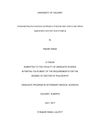TLDR Desmocollin 1 is essential for strong skin and proper skin function.
The study investigated the role of desmocollin 1 (Dsc1) in mice by disrupting the Dsc1 gene, resulting in mice with flaky skin and epidermal barrier defects shortly after birth. The absence of Dsc1 led to fragile epidermis, acantholysis, and localized lesions, which compromised skin barrier function and caused neutrophil accumulation and tissue degradation. Despite rapid wound healing preventing overt lesions initially, by 6 weeks, the mice developed ulcerating lesions similar to chronic dermatitis, accompanied by localized hair loss and hair follicle degeneration. The findings indicated that Dsc1 was crucial for strong adhesion, barrier maintenance, and proper epidermal differentiation, with potential parallels to human blistering diseases.
 69 citations
,
August 1999 in “Developmental biology”
69 citations
,
August 1999 in “Developmental biology” The nude gene causes skin cell overgrowth and improper development, leading to hair and urinary issues.
32 citations
,
November 1998 in “Journal of Biological Chemistry” Mouse and human keratin 16 can both form filaments, with differences likely due to the tail domain, not the helical domain.
86 citations
,
June 1998 in “Journal of Investigative Dermatology” The hairless gene mutation causes baldness by disrupting hair follicle structure.
96 citations
,
September 1996 in “PubMed”
 February 2024 in “ACS applied bio materials”
February 2024 in “ACS applied bio materials” Keratin microspheres might help hair grow.
27 citations
,
October 2020 in “Biomedicine & Pharmacotherapy” Hair follicle stem cells help skin heal and grow better.

Dermal stem cells help regenerate hair follicles and heal skin wounds.
 December 2017 in “Chin J Cell Stem Cell (Electronic Edition)”
December 2017 in “Chin J Cell Stem Cell (Electronic Edition)” Hair follicle stem cells help skin wounds heal faster.
50 citations
,
July 2008 in “British Journal of Dermatology” 138 citations
,
March 2007 in “Experimental cell research” Only a few hair-specific keratins are linked to inherited hair disorders.
276 citations
,
January 2005 in “International review of cytology” More research is needed to understand how hair keratins work and their role in hair disorders.
199 citations
,
January 2004 in “The International Journal of Developmental Biology” Hair follicle growth and development are controlled by specific genes and molecular signals.
29 citations
,
April 2003 in “Experimental dermatology” Human hair follicles grown in vitro maintain normal keratin patterns and structure.



